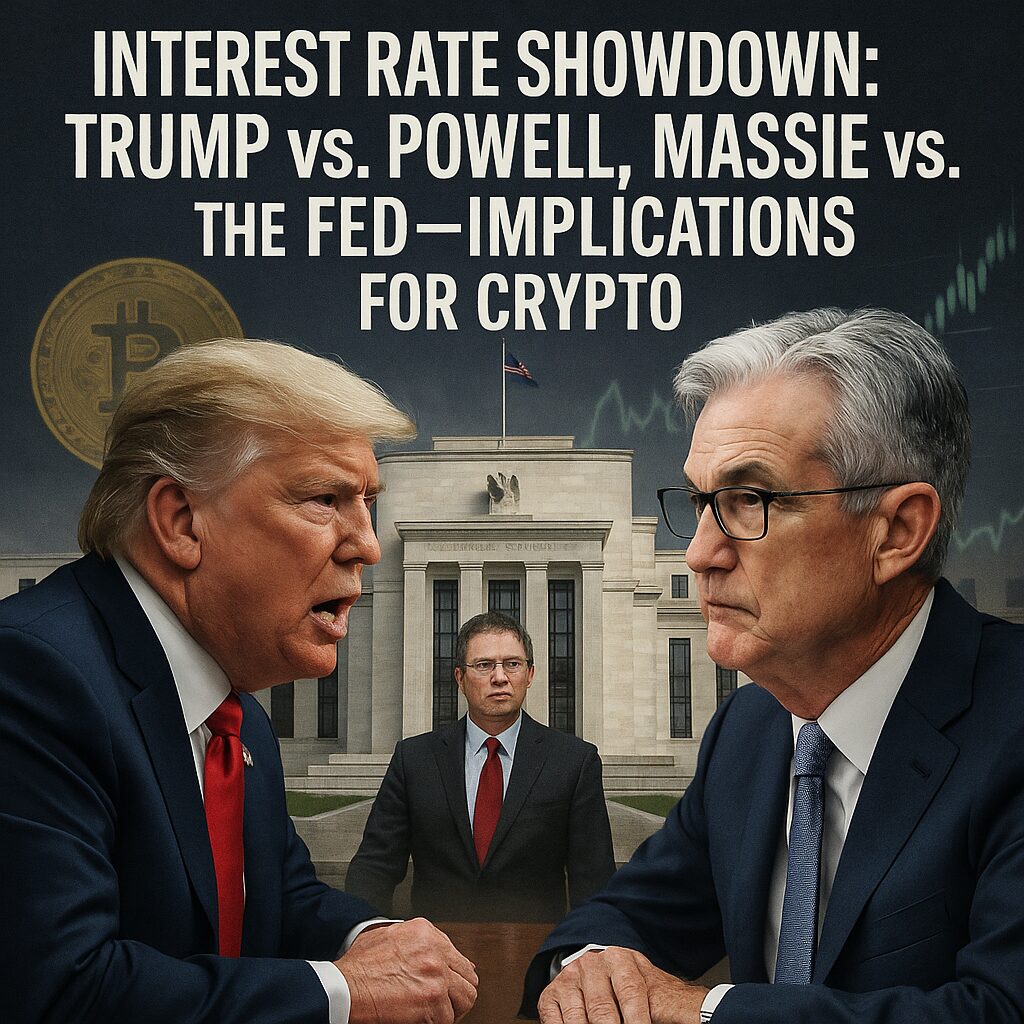
Main Points:
- President Donald Trump intensifies public attacks on Fed Chair Jerome Powell, demanding rate cuts to “save” the U.S. economy.
- Rep. Thomas Massie introduces legislation to abolish the Federal Reserve, reflecting a hard-money critique of central banking.
- The Fed has held its benchmark federal funds rate at 4.25–4.50% since December 2024, signaling caution amid sticky inflation.
- Crypto markets are sensitive to U.S. monetary policy; Bitcoin could rally 13–30% if a July cut materializes.
- Institutional analysts warn that political interference risks undermining Fed credibility, potentially increasing market volatility.
Trump’s Attack on Powell
In early July 2025, former President Donald Trump escalated his criticism of Federal Reserve Chair Jerome Powell. Trump accused Powell of imposing “trillion-dollar” losses on the nation by maintaining high rates, calling him “a foolish guy” and “clearly anti-Trump” on his Truth Social platform. He argued that lowering the federal funds rate to as little as 1–2% could save the United States up to $1 trillion annually. This rhetoric mirrors Trump’s broader strategy of exerting political pressure on an institution that is supposed to remain independent of electoral politics.
Analysts note that while Trump cannot directly remove a sitting Fed chair, public denunciations and suggestions of a “probe” into Fed projects are designed to sway investor sentiment and fuel speculation about imminent rate reductions. Indeed, after Powell indicated that rate cuts in July were possible but not guaranteed, markets briefly rallied before retracing, underscoring the delicate interplay between political statements and asset prices.
Massie’s Push to Abolish the Fed
On the legislative front, Representative Thomas Massie (R-KY) has advanced H.R. 1846, the “Federal Reserve Board Abolition Act,” which would dismantle the central bank entirely. Massie argues that the Fed’s power to “set” interest rates has been effectively neutralized by Congress’s unlimited spending and borrowing. Without the Fed’s ability to control money, he claims, true market-driven interest rates—determined by genuine savings and investment—can restore economic equilibrium.
Adherents of the Austrian School of economics, such as Massie and scholars like Thomas Sowell, warn that central bank interventions distort price signals, fuel inflation, and create moral hazard by socializing losses while privatizing gains. They contend that abolishing the Fed would force lawmakers to confront budgetary realities instead of relying on monetary expansion to finance deficits. Whether Massie’s bill gains traction remains uncertain, but it highlights a growing distrust of central banking among a bloc of U.S. policymakers.
The Fed’s State of Play
Despite political pressure, the Federal Open Market Committee (FOMC) has maintained its target range of 4.25–4.50% since December 2024. In its June 2025 statement, the Fed noted that inflation remains “stickier” than anticipated and that economic uncertainty, while reduced, is still elevated. The median projection in the Fed’s Summary of Economic Projections suggests bringing rates down to roughly 3.9% by year-end, implying two planned cuts in 2025.
Federal Reserve Chair Powell has reiterated that monetary policy decisions will be data-driven rather than politically motivated. Speaking at an ECB forum, he emphasized the Fed’s commitment to its dual mandate—price stability and maximum employment—regardless of external commentary. Nonetheless, every public challenge from Trump or congressional moves like Massie’s adds to the narrative of a central bank caught between its inflation-fighting mandate and political calls for easier money.
Crypto Market Response
Cryptocurrencies, long touted as non-correlated to traditional assets, have increasingly moved in tandem with macroeconomic indicators. In the days following Trump’s latest volley at Powell, Bitcoin saw a 4% intraday swing as market participants parsed the likelihood of a July rate cut. According to TradingView, the correlation coefficient between Bitcoin and U.S. Treasury yields has risen to 0.6 over the past quarter.
Analysts at AInvest forecast that if the Fed does deliver a rate cut in July, Bitcoin could rally between 13% and 30% as liquidity conditions improve and risk-on sentiment returns. Ethereum and other major tokens are also positioned to benefit from increased capital flows. Meanwhile, crypto derivatives markets are pricing in a roughly 50% probability of a July cut, up from 30% a month earlier, reflecting heightened expectations of monetary easing.
Institutional Perspectives and On-Chain Implications
Beyond price movements, institutional investors are re-evaluating crypto’s role as an inflation hedge. With U.S. Treasury yields offering modest real returns after accounting for inflation, digital assets present an alternative store of value—particularly in scenarios where central bank policies are perceived as increasingly politicized.
On-chain metrics reveal growing accumulation among long-term holders. Glassnode reports a 5% uptick in Bitcoin addresses holding more than one BTC over the past month, suggesting that both retail and institutional investors are positioning for the next rate-cycle shift. Staking-enabled Ethereum ETFs, which have drawn over $1.5 billion in inflows in 2025, further underscore institutional appetite for crypto exposure amid uncertain monetary policy.
Conclusion
The ongoing clash between President Trump and Fed Chair Powell, coupled with Massie’s radical proposal to dissolve the Federal Reserve, underscores a broader debate over monetary authority and market freedom. For crypto investors, these developments are far from academic. Policy decisions on interest rates directly influence liquidity, risk appetite, and the macroeconomic backdrop against which digital assets operate.
Whether the Fed bows to political pressure or stands firm on data-driven policymaking will shape the trajectory of cryptocurrencies for the remainder of 2025. With the possibility of two rate cuts on the horizon and institutional interest in blockchain assets accelerating, crypto may emerge as one of the primary beneficiaries of any shift toward easier money—just as it has in past cycles. Investors seeking new revenue sources and practical blockchain applications should monitor Fed communications closely, as the next move by Powell—or by his successor—could set off the next major crypto rally.

